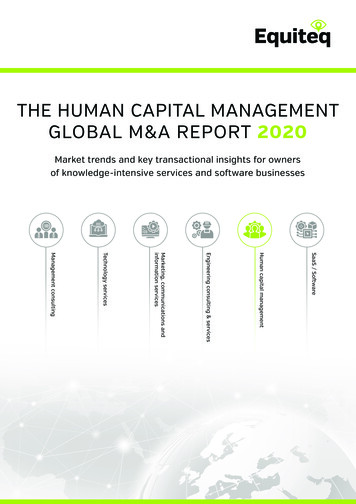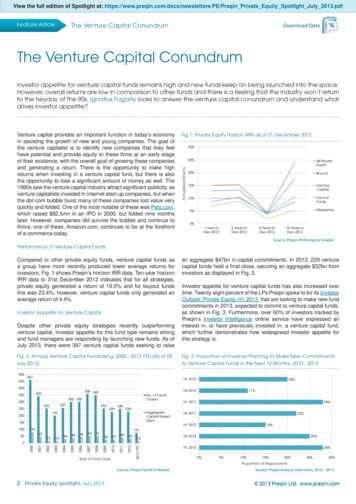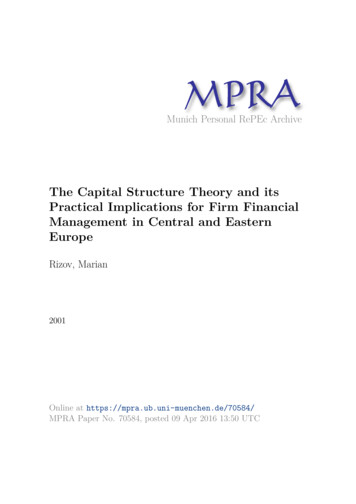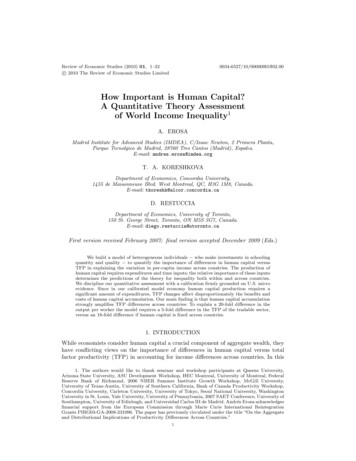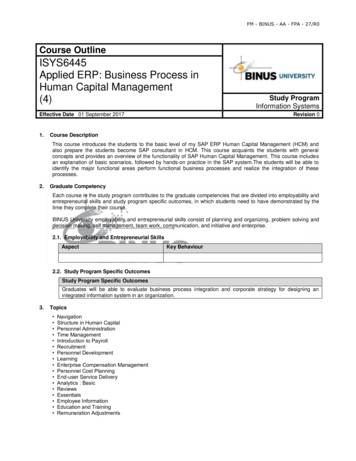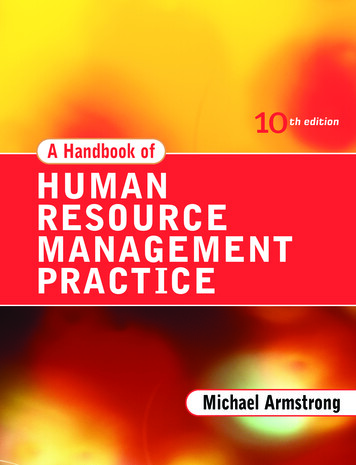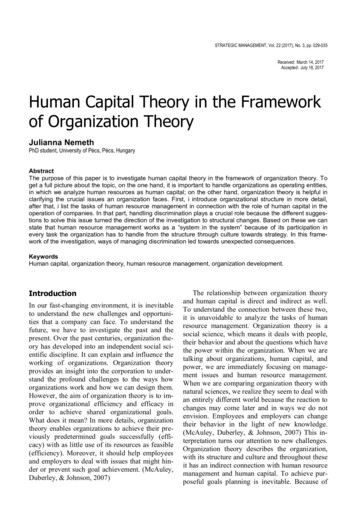
Transcription
STRATEGIC MANAGEMENT, Vol. 22 (2017), No. 3, pp. 029-035Received: March 14, 2017Accepted: July 18, 2017Human Capital Theory in the Frameworkof Organization TheoryJulianna NemethPhD student, University of Pécs, Pécs, HungaryAbstractThe purpose of this paper is to investigate human capital theory in the framework of organization theory. Toget a full picture about the topic, on the one hand, it is important to handle organizations as operating entities,in which we analyze human resources as human capital; on the other hand, organization theory is helpful inclarifying the crucial issues an organization faces. First, i introduce organizational structure in more detail,after that, i list the tasks of human resource management in connection with the role of human capital in theoperation of companies. In that part, handling discrimination plays a crucial role because the different suggestions to solve this issue turned the direction of the investigation to structural changes. Based on these we canstate that human resource management works as a “system in the system” because of its participation inevery task the organization has to handle from the structure through culture towards strategy. In this framework of the investigation, ways of managing discrimination led towards unexpected consequences.KeywordsHuman capital, organization theory, human resource management, organization development.IntroductionIn our fast-changing environment, it is inevitableto understand the new challenges and opportunities that a company can face. To understand thefuture, we have to investigate the past and thepresent. Over the past centuries, organization theory has developed into an independent social scientific discipline. It can explain and influence theworking of organizations. Organization theoryprovides an insight into the corporation to understand the profound challenges to the ways howorganizations work and how we can design them.However, the aim of organization theory is to improve organizational efficiency and efficacy inorder to achieve shared organizational goals.What does it mean? In more details, organizationtheory enables organizations to achieve their previously predetermined goals successfully (efficacy) with as little use of its resources as feasible(efficiency). Moreover, it should help employeesand employers to deal with issues that might hinder or prevent such goal achievement. (McAuley,Duberley, & Johnson, 2007)The relationship between organization theoryand human capital is direct and indirect as well.To understand the connection between these two,it is unavoidable to analyze the tasks of humanresource management. Organization theory is asocial science, which means it deals with people,their behavior and about the questions which havethe power within the organization. When we aretalking about organizations, human capital, andpower, we are immediately focusing on management issues and human resource management.When we are comparing organization theory withnatural sciences, we realize they seem to deal withan entirely different world because the reaction tochanges may come later and in ways we do notenvision. Employees and employers can changetheir behavior in the light of new knowledge.(McAuley, Duberley, & Johnson, 2007) This interpretation turns our attention to new challenges.Organization theory describes the organization,with its structure and culture and throughout theseit has an indirect connection with human resourcemanagement and human capital. To achieve purposeful goals planning is inevitable. Because of
30Julianna NemethHuman Capital Theory in the Framework of Organization Theorythat organizational management should have anappropriate planning for its resources. One of theresources which are strategically important for thecompany is human resources which is a significant component for strategic planning. Humanresource planning is a process for measuring thedemand and evaluating the nature and size of supplies it helps to meet the request. Because of theabove human resource planning is directly connected to strategic planning and institutional policies. (Bagheri, 2016)In the section below, i will introduce keyaspects of organization theory in connection withhuman resource management (HRM) and humancapital. The literature review starts with the analysis of corporate structure as invisible control, afterthat the next part deals with organization culture,followed by how companies can and should handle discrimination. Every part of the literaturereview will start with hypotheses. As a result ofthe literature overview in the last part in HR as anintegral system, I would introduce a model whichbecame the result of the investigation.Literature review and hypothesesI would like to inspire innovative thinking andprovide information for new streams of researchwith providing insight into the role of humancapital theory in the framework of organizationtheory.1.1. Organizational structure as invisiblecontrolHypothesis 1: Organizational structure is a formof hidden control.Throughout history, management has been trying to find the best possible way to organize theirworkforce for creating maximum value. (Altman,2016) As organizations are becoming incrementally structured around projects the role of teamsare increased, the focus of research articles haschanged from traditional organization structuresto new ones because structure demonstrates hierarchy which leads to power. This new broad examination of how human resource managementand practice can be furthered points to new waysof studying attributes of the connections betweenjobs and individuals. (Hollenbeck & Jamieson,2015) It is easy to realize that new organizationalstructures lead to new forms of organizationaltasks which lead to new ways of how individualshandle their work, how effective they are. Theway employees are organized can create synergy,but it can also impede. Determining organizaSTRATEGIC MANAGEMENT, Vol. 22 (2017), No. 3, pp. 029-035tional structure involves automating HR processes, coordinating hiring, pay, promotion responsibility, defining transaction routing, security.Based on this, the structure defines who has access to which workers' data and who gets whatreport. Previously hierarchy has been the dominant element of organization structure. Hierarchies are all about control and command, who issupervising others, and who is the supervisor of asupervisor until the top node is reached. (Altman,2016) It was always an important question whohas power within the organization. Based onWrong (1968) power equals control because whenyou are in a management position, and you haveposition power, you are able to control people.We need to understand that each companyneeds its power structure, a particular hierarchicalstructure to be competitive enough on the market.Leading a corporation with strict hierarchicalstructure is always easier than leading a companywhere we cannot realize the control lines. Management control systems (MCSs) are essentialparts of every organization’s life. MCSs includeeverything in which managers help to ensure theproper implementation of corporation’s plans andstrategies or if conditions require then to do somemodifications. Results control is also part ofMCSs, and this is significant because it involvesmotivation of employees to produce theappropriate amount of products in a decent quality. This type of management control demandsperformance evaluations and measures which areconnected to the compensation policies in the vastmajority of organizations. Incentives are part ofcompensation policy which consists of monetaryincentives, like stock options or bonuses andnonmonetaryincentives,likeautonomy,recognition, and praise. Autonomy turned backour attention to hierarchical structures and the factthat structure is a hidden control. (Merchant &Van der Stede, 2007) There are other types oforganizational structures, as well, such as organizations with matrix structures or virtual organizations. We can state that the high-performing organizations of today are a network of teams whichrequire an entirely new way of thinking aboutgoals, leadership, roles, jobs and tools what weuse to share information and measure the success.There are, of course, always new types of organizational structures such as holacracy (flat, flexible organizational structure, gives more autonomyto individuals and teams) and sociocracy (peopleorganized in circles, with representatives bridgingfrom one circle to another, consent decision mak-
Julianna Nemething). (Altman, 2016) To be able to adopt a newstructure successfully, the company needs to havean open-minded leader who can create an innovative environment with an appropriate organizational culture.1.2. Organizational culture’s effect onstrategic human resource managementHypothesis 2: Organizational culture is one of thedecisive components of organization theory andHRM.We have already talked about strategic planning and structure. In this part, the focus changesto the social part of the company. Human resourcemanagement (HRM) practices provide employeeswith incentives, information, skills, and decisionmaking responsibility that are highly connected todeveloping business performance. As every organization has its particular structure andhierarchy, they have their organizational culture,as well, which depends on the different nationalculture. (Al-Sarayrah, Tarhini, Obeidat, Al-Salti,& Kattoua, 2016) National cultures are not identical to one another. Organizational and domesticculture are different terms. (Hofstede, 1993)Corporate cultures are distinct from each othereven though the companies may reside in thesame country. They shape organizations’ processes because corporate culture refers to the beliefs, values, and practices that are shared by organizational members. This culture helps to holdthe whole organization together by providingstandards for employees to know what theyshould say and do. In other words, it guides employees’ behavior and attitudes to do the rightthing. (Robbins & Judge, 2013) The main difference between organizational culture and nationalculture is the fact that national culturedistinguishes members of one nation from anotherone while corporate culture distinguishes organizational members from other organization’s employees. The understanding of different nationalcultures is crucial for international managers touse the appropriate, culturally specific management philosophy and techniques. (Al-Sarayrah etal., 2016) Training can help managers to knowhow to handle different situations in internationalorganizations where different cultures are livingtogether under the umbrella of organizational culture. Developing and assessing human capital is acentral, most significant goal for every singleteam. Training is a basic task of HRM; however,training interventions not always get the full support from leadership. This intervention will beHuman Capital Theory in the Framework of Organization Theorymuch more efficient if employees have theessential support network within which they candiscuss their newly acquired skills and knowledgeand have the appropriate social environment inwhich they feel comfortable trying out their newlylearned materials. (Hollenbeck & Jamieson, 2015)In the following section, we are arriving at themost sensitive topic of this paper, which is handling discrimination. Organization theory dealswith organizational practices, policies, and hierarchies. Among the phenomena of organizationalpractices we can observe the glass ceiling effectand the relatively new phenomenon “glass cliff”.The “glass effects” are defined by organizationalpractices and policies consequently they are affected by organizational structure.1.3. Handling discriminationHypothesis 3: Human resource managers cannothandle discrimination by themselves.Based on Mathis and Jackson, (2010, p. 4)human resource management is designing themanagement systems in order to ensure that human (capital’s) talent is used efficiently andeffectively to accomplish organizational goals. Inother words, we are starting to play chess withpeople. When we are trying to ensure that talent isused efficiently, we are focusing on theperformance of the company. Efficiency in thecase of organizations mostly connected to costefficiency. To build a sustainable, efficientcorporation, we should concentrate on diversity.Diversity means more diverse, differently talentedindividuals in one place. As diversity is growingin the corporation, the performance level will develop. To improve performance, we have to ensure equal employment opportunities and helpprotected-class members to become effective.Protected class members are people who are different based on: race, colour, ethnic origingenderagedisabled peoplemilitary experiencereligionmarital statussexual orientation (Mathis & Jackson,2010).Protected class members are individuals whoare members of the protected category underEqual employment opportunity (EEO) laws andSTRATEGIC MANAGEMENT, Vol. 22 (2017), No. 3, pp. 029-03531
32Julianna NemethHuman Capital Theory in the Framework of Organization Theoryregulations. In the first figure, we can see the gender wage gap in the different Canadian provinces,in 2014. The sample consists of private sectoremployees aged 25-59. I chose this figure as anindication because Canada is a significant, developed country which means that statistics fromdeveloping countries would show higher differences. You can see clearly that wage gap stillexists between males and females in everyprovince. We can find evidence that companiesare still trying to solve discrimination issueswhich mean it is not solved.Figure 1 Average hourly wage in differentCanadian provinces based on genderSource: Schirle, 2015Gardiner (2016) asked Iris Bohnet in an interview to analyze the leading causes of fightingagainst discrimination. Based on the interview, wecan state that the problem still exists because thedifferent discrimination programs do not work.Many American corporations conduct diversitytraining without measuring whether they are effective or ineffective. The reason behind inefficiency is the fact that the problem is within theorganizational structure and not within people.Companies need to redesign their different processes in order to prevent discriminative choices.Human thinking is stubborn; it is very hard toeliminate biases even when we are trying. That iswhy it is necessary to redesign organizations tomake it easier for our minds to get things right. Inthe case of recruitment, you can use software toput job candidates “behind the curtain.” Thissoftware allows the managers to skip discrimination biases towards, age, gender, race or anothersocioeconomic background so they can focus ontalents only. Managers should be conscious aboutthe recruitment language that they use in thisprocess. After that, they have to focus only onhard data because this process does not allowSTRATEGIC MANAGEMENT, Vol. 22 (2017), No. 3, pp. 029-035them to be biased based on their subjectiveevaluation. Gender discrimination is probably themost significant one because sometimes even thevictims cannot see where things went wrong. Wehave to face the fact the humans are differentbased on their gender, as well. It is hard to focuson every aspect of the job, but once a managerstarts to collect hard data those will be helpfulbecause they allow us to study the phenomenonand to make changes and measure the progress.(Gardiner, 2016)An HR manager does not work alone. Theyhave to work in close collaboration with the functional areas of business, such as marketing andfinance, and as it was already discussed with thetop managers in order to develop the appropriatestrategy. It can be a highly significant goal topromote the company’s name as the best employer, or the best workplace. The employmentbranding of a corporation means that applicantssee the organization as a desirable place to workfor and because of that the company is able toattract more highly qualified applicants than thosewhose employment image is poor. These taskscan be connected to the marketing efforts of thecompanies. In the case of finance, we cannot forget the fact that human capital requires compensation which means we have to design a satisfyingwage structure which fits the corporate and HRstrategy. In this case, we arrive at the point when Iintroduce the second largest HR task which isconnected to discrimination, reducing genderwage gap.Despite decades of political mobilization andnew directions of public policy, the differencesbetween females’ and males’ wages remain one ofthe most significant forms of workplace inequality. Comparisons of salaries for female and maleworkers consistently reveal that female employeesearn substantially less than similarly qualifiedmen working in the same positions. To understandthe sources of this kind of inequality, a significantnumber of research articles have focused on therole of organizational pay systems and practiceswithin the United States, Canada and even inGermany. (Abraham, 2017; Abendroth, Melzer,Kalev, & Tomaskovic-Devey, 2017; Graham,Belliveau, & Hothchkiss, 2017; Schirle, 2015)Schirle (2015) made a gender wage gap analysis for the period of 1997-2014 to see the differences between the years. She realized that thegender wage gap narrowed substantially in someprovinces while in others the differences changedonly a little. The provincial differences in the size
Julianna Nemethof the gap were mainly reduced when the genderdifferences in job characteristics were taken intoconsideration. Equal employment opportunity andaffirmative action have a limitation to their success rate because of the pre-labor market genderimbalances. It is not enough to reduce the differences in the workplace we have to focus on theequal opportunities in education as well.In the case of the American gender wage gap,the literature is considerable. There are studieswhich deal with workplace cultures, or hierarchies, but most of the articles are dealing withcompensation systems. In the past years, therewere papers about the formalization of pay systems and how they can reduce inequalities, butsome of the recent studies suggest otherwise. Thegoal of Abraham’s (2017) study was to determinewhether female and male managers differ in howthey are handling less formalized pay systems.Abendroth et al. (2017) studied, in Germany,whether and how gender differences in the case ofpower associated with gender differences in earnings. Based on these articles we can state that it isimportant to develop an appropriate pay systembecause male managers like to make advantagesfor their in-group members while females behaveotherwise. They prefer male managers and do notpay more for their female co-workers out of jealousy, lack of self-confidence, lack of selfawareness, and because they feel threatened byother women workers.In this study, i would like to advance our understanding of the relationship between handlingdiscrimination and human resource management.It was evident that HR managers should highlyfocus on equal employment opportunities in different human resources practices and policies, butthese last articles made it clear that discriminationis closely connected to financial aspects of thecompany, as well. To be able to build a bias-freeorganization it is indispensable to design a formalized pay system and to think over the previouslyused strategic processes, to collect hard data aboutemployees and measure them in an appropriatediscrimination-free process. These together willhelp to ensure that the company has a sustainablestrategy.1.4. Human capital theoryHypothesis 4: As an aspect of organization theory,human capital theory is still changing.Human capital measurement is not a newtopic; researchers have been dealing with it sincethe middle of the last century. However, thereHuman Capital Theory in the Framework of Organization Theorywere different researches, from the years of the1950s, about the determination of the value ofhuman capital there is no single model what thecompanies can use. The history of human capitalmeasurement helps the experts in developing anew paradigm which can show the real value ofhuman capital. Accounting calculates with humancapital in another aspect it is using data from pastevents and data. With the development of humancapital valuation, there is an opportunity to focuson the future and determine a new system. Thisnew regime could use the development of different systems without their mistakes.In their article, Folloni and Vittadini (2010)examined human capital evaluation from the beginning of 1600. Thanks to their extendedresearch, which consists of more than 400 years,they were able to introduce different models: costbased model by Engel from 1883 and Dublin &Lotka from 1930, value-based model by Farr from1853, present value based model by Jorgensonand Frauemeni from 1989, referred to Folloni andVittadini in their 2010 article.None of these models determined the realvalue of human capital. The writers concludedthat although there are hundreds of different articles which deal with human capital theory there isnot a unified accepted view. The recent researchesare dealing with family background, culture,skills, marital status, gender, and lifestyle not justwith education and wages.Schultz, Chowdhury and Van de Voort (2013)stated that we could determine human capitalthrough his or her productive abilities which arecoming from: education, qualifications, participation in training and working experiences. There isa new view of human capital which requires theperfect motivation of employees which leads us toSelf-determination theory. Those people who areperfectly motivated are willing to learn and putspecial knowledge and skills into their workinghabits to improve the effectiveness of the company. Based on the theory we can state that individuals who have intrinsic motivation are muchmore valuable for an organization than a demotivated worker or employees with extrinsicmotivation because people with intrinsic motivation have an inherent desire to finish the tasks,jobs to increase organizational performance. (Deci& Ryan, 2000)2. MethodologyIn this paper I chose desktop research that is literature review as a method. It is important toSTRATEGIC MANAGEMENT, Vol. 22 (2017), No. 3, pp. 029-03533
34Julianna NemethHuman Capital Theory in the Framework of Organization Theoryshow a clear research overview because it givesthe opportunity to understand the background ofthe topic and to learn the new information betterhere. This study aims to review the literature thatshows the relationship between human capital on of the research on the concepts ofhuman resource management, strategic humanresource management, organizational structure,corporate culture, handling discrimination will bediscussed briefly. After showing the backgrounddata and processes, the paper shows some alternative solutions to the problems. This article willprovide insights for management to recognize theimpact of organization theory on human capital.3. HR as an integral systemIf we think of HR as an integral system, it meanswe cannot separate it from other parts of the organization such as: structureculturefinancemarketingstrategyI have already introduced the topic from thestructural and cultural point of view because thesetwo are closely connected to organization theory.In the first figure, you can see the underlying relationships between these fundamental functionswithin the framework of organizational theory andhuman resource management in connection withhuman capitals.As we have already discussed, the evaluationof human resources makes it to the most valuableasset of the organizations, but only a few company can employ its full potential. The tasks ofhuman resource management involve all managerial personnel duties such as recruitment, hiring,selection, placement, compensation, training, andterminations, as well. All these process humanresource management can enhance organizationalperformance. (Al-Sarayrah et al., 2016)ConclusionAs a conclusion, I can state that I found evidenceto decide whether the above-described hypothesessuch be rejected or accepted.The first hypothesis: Organizational structureis a form of invisible control: it should be accepted because structure is not immediately visible but guides human behavior. Hierarchy anddifferent designs are not always directly visible,but they have control over what you can and cannot do within the organization.The second hypothesis: Organizational cultureis one of the decisive components of organizationtheory and HRM: should be accepted. However,we can find only a limited amount of evidencethat corporate culture has a measurable effect onorganization theory. National and entrepreneurialculture has a significant impact on the life of thecompany and through that to organization theory.The third hypothesis: Human resource managers cannot handle discrimination by themselves:should be accepted because to build a bias-freeorganization all functions have to work together ina synchronized way. HR managers should workclosely with marketing, finance, and operationalmanagers to develop a newly designed corporation where discrimination is limited.The fourth hypothesis: As an aspect of organization theory, human capital theory is still changing: could be accepted. There is no universal human capital evaluation method at the market ofcompany evaluations. From year to year, there arenewer and newer valuation systems, but there isno evident “one best way” of human capitalvaluation.SummaryFigure 2 Capture (Style: SM-PictureHeading)Source: AuthorsSTRATEGIC MANAGEMENT, Vol. 22 (2017), No. 3, pp. 029-035This paper aimed to shed light on the relationshipbetween human capital theories in the frameworkof organization theory. I presented the connections between organizational structure, culture,and organization theory. I also discussed human
Julianna Nemethresource management and its link to human capital theory. Finally, I briefly reviewed human resource management as an integral system. Thisstudy will provide insights for management torecognize the relationship between organizationtheory and human capital and evaluate the impacton the performance of the whole organization. SMReferencesAbendroth, A., Melzer, S., Kalev, A., & Tomaskovic-Devey,D. (2017). Women at work: Women’s access to powerand gender earnings gap. ILR Review, 70 (1), 190-222.Abraham, M. (2017). Pay formalization revisited:Considering the effects of manager and discretion onclosing the gender wage gap. Academy of ManagementJournal, 60 (1), 29-54.Al-Sarayrah, S., Tarhini, A., Obeidat, B. Y., Al-Salti, Z., &Kattoua, T. (2016). The effect of culture on strategichuman resource management practices: A theoreticalperspective. International Journal of BusinessManagement and Economic Research, 7 (4), 704-716.Altman, R. (2016). HR Organizational Structure - Past,Present, and Future. Workforce Solution Review, JulyIssue, 13-15.Bagheri, J. (2016). Overlaps between human resources’strategic planning and strategic management tools inpublic organizations. Procedia-Social and BehavioralSciences, 230, 430-438.Deci, L. E., Ryan M. R. (2000). Self-Determination Theoryand the Facilitation of Intrinsic Motivation, SocialDevelopment, and Well-Being. American Psychologist,55 (1), 68-78.Human Capital Theory in the Framework of Organization TheoryGraham, M. E., Belliveau, M. A., & Hotchkiss, J. L. (2017).The view at the top or signing at the bottom? Workplacediversity responsibility and women’s representation inmanagement. ILR Review, 70 (1), 223-258.Hofstede, G. (1993). Cultural constraints in managementtheories. Academy of Management Executive, 7 (1), 8194.Hollenbeck, J. R., & Jamieson, B. B. (2015). Symposium:Human capital, social capital, and social networkanalysis: Implications for strategic human resourcemanagement. Academy of Management Perspectives,29 (3), 370-385.Mathis, R. L., & Jackson, J. H. (2010). Human resourcemanagement (13th ed.). London: Cengage Learning.McAuley, J., Duberley, J., & Johnson, P. (2007).Organization Theory - Challenges and Perspectives.London: Pearson Education Limited.Merchant, K. A., & Van der Stede, W. A. (2007).Management Control System - Performancemanagement, evaluation, and incentives (2nd ed.).London: Prentice Hall.Robbins, S. P., & Judge, T. A. (2013). OrganizationalBehaviour (15th ed.). New Jersey: Pearson EducationLimited.Schirle, T. (2015). The gender wage gap in the Canadianprovinces, 1997-2014. Canadian Public Policy, 41 (4),309-318.Schulz, E., Chowdhury, S., Van De Voort, D. (2013). Firmproductivity moderated link between human capital andcompensation: the significance of task-specific humancapital. Human Resource Management, 52 (3), 423439.Wrong, D. H. (1968). Some Problems in Defining SocialPower, American Journal of Sociology, 73 (6), 673-681.Folloni, G., & Vittadini, G. (2010). Human capitalmeasurement: A survey. Journal of Economic Surveys,24 (2), 248-279.Gardiner, M. (2016). Designing a bias-free organization It’s easier to change your processes than your people.Harvard Business Review, July-August, 62-67. CorrespondenceJulianna NemethPhD student, University of Pécs48-as tér, 7622, Pécs, HungaryE-mail: nemethj@ktkt.pte.huSTRATEGIC MANAGEMENT, Vol. 22 (2017), No. 3, pp. 029-03535
Human capital, organization theory, human resource management, organization development. Introduction In our fast-changing environment, it is inevitable to understand the new challenges and opportuni-ties that a company can face. To understand the future, we have to investigate the past and the present. Over the past centuries, organization the-



